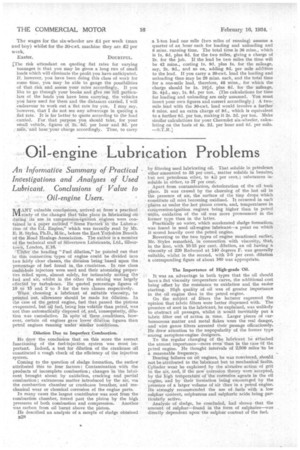Oil-engine Lubrication Problems
Page 38

If you've noticed an error in this article please click here to report it so we can fix it.
An Informative Summary of Practical Investigations and Analyses of Used Lubricant. Condmions of Value to Oil-engine Users. • ur ANY valuable conclusions, arrived at from a practical lvi study of the changeS that take place in lubricating oil during its use in compression ignition engines were contained in a piper entitled " Some FactorS hi-the Lubrication of the Cii.. Engine," which was recently read by Mr. Fa R. Styles, Ph.D., M.Sc., before the East Yorkshire Branch of the Road Haulage Association. The author is a member ofthe technical staff of Silvertown Lubricants, Ltd., Silvertown, town, London, E:16.
'under the heading "Fuel dilution," he pointed out that io this connection types of engine could be divided into two fairly clear classes, the division being-based upon the percentage of fuel found in the crankCase. In one class multi-hole injectors were used and their atomizing properties relied upon,. almost solely, for intimately mixing thekiel and air, whilst in the other the mixing was largely effected by turbulence. He quoted percentage figures of 10 to 15 and 2 to 5 for the two classes respectively.
When choosing ;a: lubricant of suitable viscosity, he pointed out, allowance should be made for dilution. In the case of the :petrol engine, fuel that passed the pistons evaporated, but oil fuel, being less volatile than petrol, was not thus automatically disposed of, and, consequently, dilution was cumulative. In spite of these :conditions, however, certain oil engines gave lower dilution figures than petrol engines runningunder similar conditions.
Dilution Due to Imperfect Combustion.
He drew the conclusion that on this score the correct functioning of the fuel-injection system was most important. Indeed, a test for dilution of the crankcase -oil constituted a rough check of the efficiency of the injection system.
Coming to the question of sludge formation, the author attributed this to four factors : Contamination with the products of incomplete combustion; changes in the lubricant brought about by oxidation, cracking and partial combustion ; extraneous matter, introduced by the air, via the combustion chamber or crankcase breather, and mechanical wear or chemical corrosion of the engine parts.
In many cases the largest contributor was soot from the combustion chamber, forced past the piston by the high pressures of both combustion and compression. Another was carbon from oil burnt above the piston. He described an analysis of a sample of sludge obtained B28
by filtering used lubricating oil. That soluble in petroleum. ether amounted to 58 per cent., matter soluble in benzine, but not petroleum ether, to 4.2 per cent.; substances insoluble in either, to 37 per cent.
Apart from contamination, deterioration of the oil took place. It was caused by the churning of the hot oil in the presence of air, the ,surface of the tiny drops which constitute oil mist becoming oxidized. It occurred in such places as under the hot piston crown, and, temperatures in compression-ignition engines being higher than in petrol units, oxidation of the oil was more pronounced in the former type than in the latter. Practically no water, which accelerated sludge formation, was found in used oil-engine lubricant--a point on which it scored heavily over the petrol engine. Reverting to the two types of engine mentioned earlier, Mr. Styles remarked, in connection with viscosity, that, in the first, with 10-15 per cent, dilution, an oil having a viscosity of 220 Redwood at 140 degrees F. was generally suitable, whilst in the second, with 2-5 per cent, dilution a corresponding figure of about 160 was appropriate.
The Importance of High-grade Oil.
It was an advantage in both types that the oil should have.a flat viscosity temperature curve, the additional cost being offset by the resistance to oxidation and the easier starting. High quality of oil was of greater importance in the oil engine than in the petrol engine.
On the subject of filters the lecturer expressed the opinion that fabric filters were better dispensed with. The presence of soot in the lubricant, he explained, was unlikely to obstruct oil passages, whilst it would inevitably put a fabric filter out of action in time. Larger pieces of carbonaceous matter and metal flakes were the real danger, and wire gauze filters arrested their passage efficaciously. He drew attention to the unpopularity of the former type among aeroplane-engine designers. To the regular changing of the lubricant he attached the utmost importance—more even than in the case of the petrol engine. He thought intervals of 2,500 miles to be a reasonable frequency.
Bearing failures on oil engines, he was convinced, should not be attributed to the lubricant but to mechanical faults. Cylinder wear he explained by the abrasive action of grit in the air, and,.if the new corrosion theory were accepted, by the high temperature. of 'the corrosive agents in the oil engine, and by their formation being encouraged by the presence of a larger volume of air than in a petrol engine. He stmngly, recommended the use of fuels with a low sulphur content; sulphurous and sulphuric acids being particularly active.
Analysis of sludge, he concluded, had shown that the amount of sulphur—found in the form of sulphates—was directly dependent upon the sulphur content of the fuel.




















































































